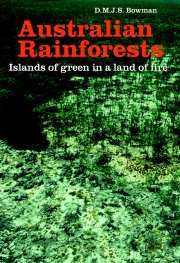Book contents
- Frontmatter
- Contents
- Preface
- 1 Introduction
- 2 What is Australian rainforest?
- 3 The sclerophyll problem
- 4 The edaphic theory I. The control of rainforest by soil phosphorus
- 5 The edaphic theory II. Soil types, drainage, and fertility
- 6 The climate theory I. Water stress
- 7 The climate theory II. Light and temperature
- 8 The fire theory I. Field evidence
- 9 The fire theory II. Fire, nutrient cycling, and topography
- 10 The fire theory III. Fire frequency, succession, and ecological drift
- 11 The fire theory IV. Aboriginal landscape burning
- 12 The fire theory V. Aridity and the evolution of flammable forests
- 13 The fire theory VI. Fire management and rainforest conservation
- 14 Summary
- References
- Index
9 - The fire theory II. Fire, nutrient cycling, and topography
Published online by Cambridge University Press: 23 November 2009
- Frontmatter
- Contents
- Preface
- 1 Introduction
- 2 What is Australian rainforest?
- 3 The sclerophyll problem
- 4 The edaphic theory I. The control of rainforest by soil phosphorus
- 5 The edaphic theory II. Soil types, drainage, and fertility
- 6 The climate theory I. Water stress
- 7 The climate theory II. Light and temperature
- 8 The fire theory I. Field evidence
- 9 The fire theory II. Fire, nutrient cycling, and topography
- 10 The fire theory III. Fire frequency, succession, and ecological drift
- 11 The fire theory IV. Aboriginal landscape burning
- 12 The fire theory V. Aridity and the evolution of flammable forests
- 13 The fire theory VI. Fire management and rainforest conservation
- 14 Summary
- References
- Index
Summary
Webb (1968) noted that although rainforests typically favour nutrient-rich or eutrophic soils, this correlation is not causal in the sense that rainforest trees have a physiological dependence upon high levels of soil nutrients. Rather, he argued that the occurrence of rainforest on eutrophic soils is more a consequence of the overarching effect of fire on the growth and survival of rainforest trees. Thus soil fertility is not merely determined by the underlying geology of a site but by fire history, nutrient cycling and topography. For instance, Webb argued that, in seasonally dry and geologically infertile environments, rainforest is restricted to topographically fire-protected sites, and that the absence of burning allows rainforest to enrich soils by nutrient cycling. The purpose of this chapter is to critically consider the role of nutrient cycling, fire and topography in creating differences in soil fertility between rainforest and non-rainforest vegetation.
Nutrient cycling and rainforest soil fertility
The view that differences in nutrient cycling contribute to the higher soil fertility of rainforest compared with adjacent non-rainforest is supported by the available data. For instance, Chandler and Lamb (1986) provide data on differences in nutrient use by rainforest and non-rainforest vegetation using the index of ‘nutrient use efficiency’ developed by Vitousek (1984).
- Type
- Chapter
- Information
- Australian RainforestsIslands of Green in a Land of Fire, pp. 185 - 195Publisher: Cambridge University PressPrint publication year: 2000



